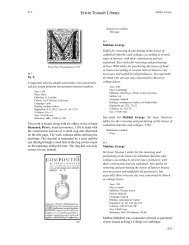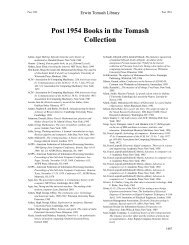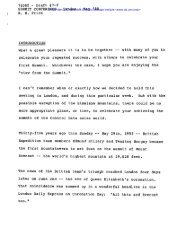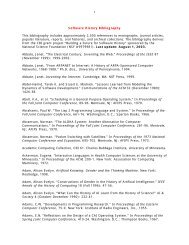B chapter.indd - Charles Babbage Institute - University of Minnesota
B chapter.indd - Charles Babbage Institute - University of Minnesota
B chapter.indd - Charles Babbage Institute - University of Minnesota
Create successful ePaper yourself
Turn your PDF publications into a flip-book with our unique Google optimized e-Paper software.
Erwin Tomash Library<br />
Boole, George Booth, Andrew Donald<br />
B 201<br />
Boole, George (1815–1864)<br />
A treatise on the calculus <strong>of</strong> finite differences.<br />
Year: 1860<br />
Place: Cambridge<br />
Publisher: Macmillan<br />
Edition: 1st<br />
Language: English<br />
Binding: original cloth boards<br />
Pagination: pp. [viii], 248<br />
Collation: π 4 1–15 8 16 4<br />
Size: 190x126 mm<br />
This work contains material for which George Boole was<br />
well known in his lifetime but which is now so completely<br />
overshadowed by his contributions to mathematical logic<br />
as to be almost forgotten.<br />
Illustrations available:<br />
Title page<br />
B 202<br />
Booth, Andrew Donald (1918–)<br />
Numerical methods<br />
George Boole, B 200<br />
Year: 1955<br />
Place: London<br />
Publisher: Butterworths Scientific Publications<br />
Edition: 1st<br />
Language: English<br />
Binding: original cloth boards<br />
Pagination: pp. viii, 196<br />
Size: 218x136 mm<br />
B 201<br />
Booth was a member <strong>of</strong> staff at Birkbeck College in<br />
London. He became interested in computation early in<br />
his career. Immediately after World War II, he had an<br />
opportunity to visit the United States and see computer<br />
developments there. In particular, he spent some time<br />
at the <strong>Institute</strong> for Advanced Study. Upon his return to<br />
England, he commenced the construction <strong>of</strong> a small<br />
relay-based computer (he was unable to afford electronic<br />
components, and, more importantly, the infrastructure that<br />
would be required to both experiment with and construct<br />
the final circuits). He was aided in this project by his<br />
father, a fine mechanical engineer, and Miss Kathleen<br />
Britten, who later became his wife. These projects are<br />
described in the works noted in other entries.<br />
Booth was known for the creation <strong>of</strong> a number <strong>of</strong><br />
computing machines all based upon the same basic<br />
design. He and his father eventually went into business<br />
as Wharf Engineering and produced magnetic drums that<br />
were widely used on early computers. In the early 1960s,<br />
Booth again visited the U.S., then moved to Canada as<br />
dean <strong>of</strong> engineering at the <strong>University</strong> <strong>of</strong> Saskatchewan,<br />
where he continued to make small transistor computers<br />
for experimental use. He later became president <strong>of</strong><br />
Lakehead <strong>University</strong> in Canada.<br />
This work on numerical methods was published just<br />
as the computer revolution was beginning and was<br />
one <strong>of</strong> the first books to be oriented towards this new<br />
technology. The students who used this text at Birkbeck<br />
173







